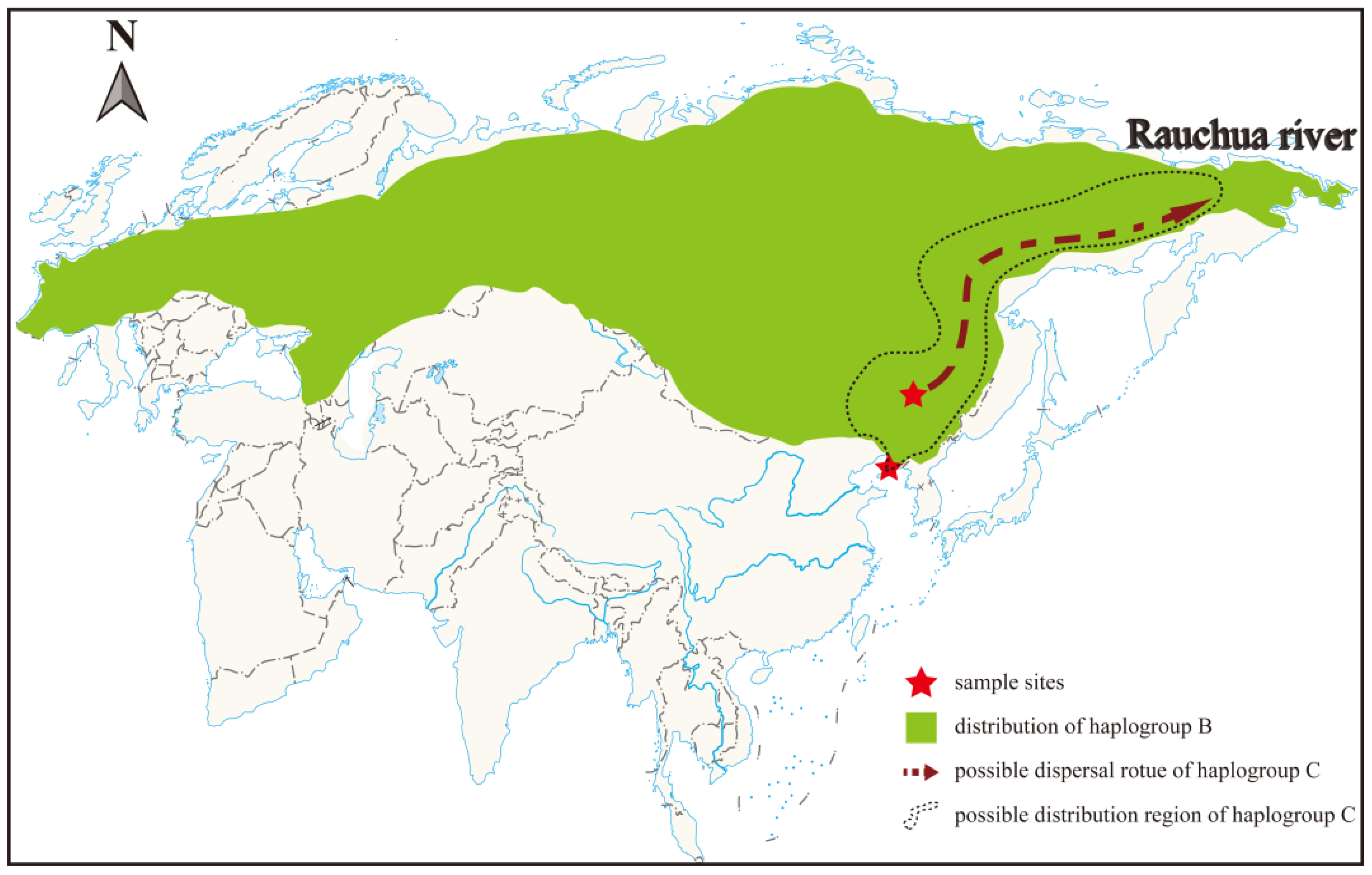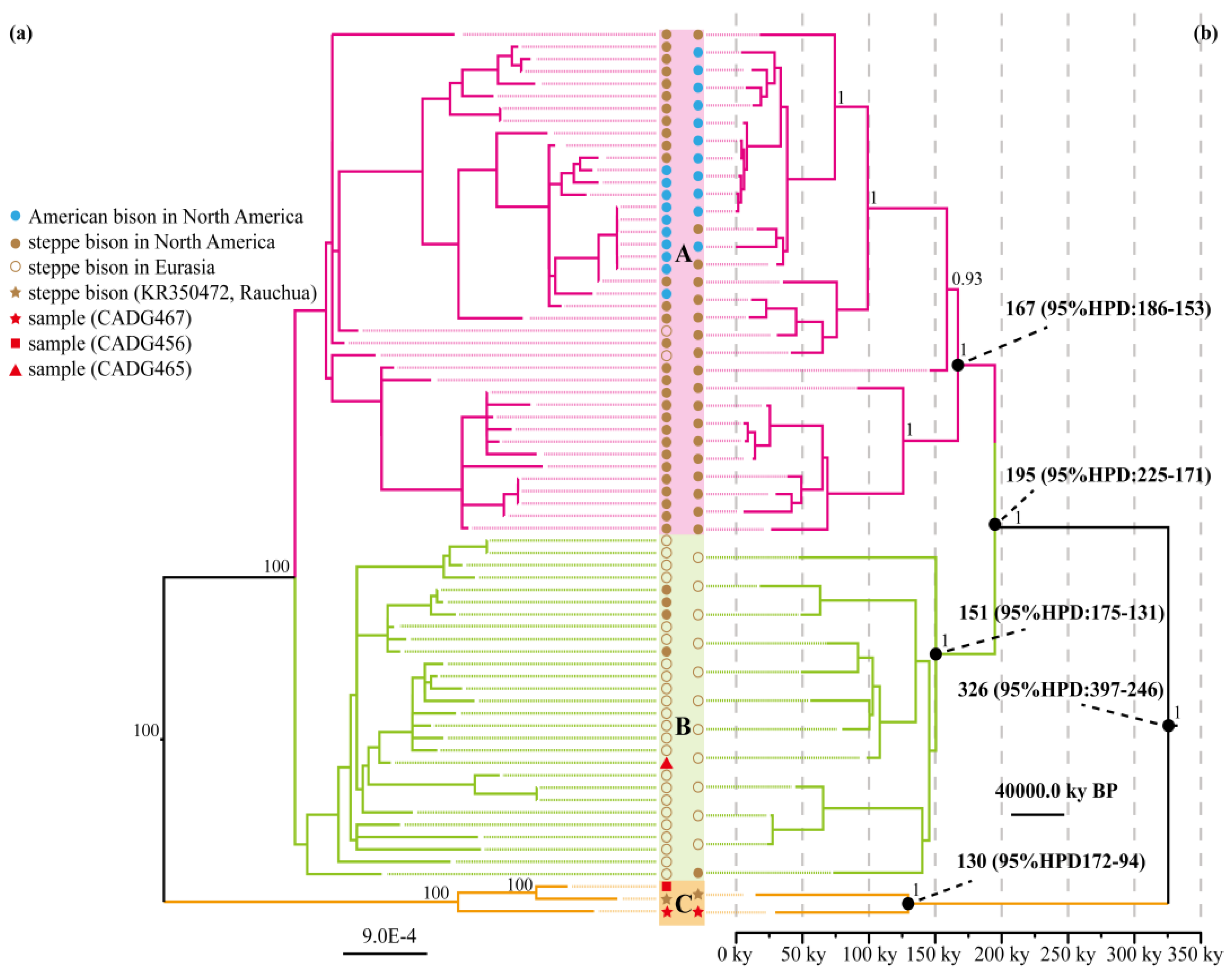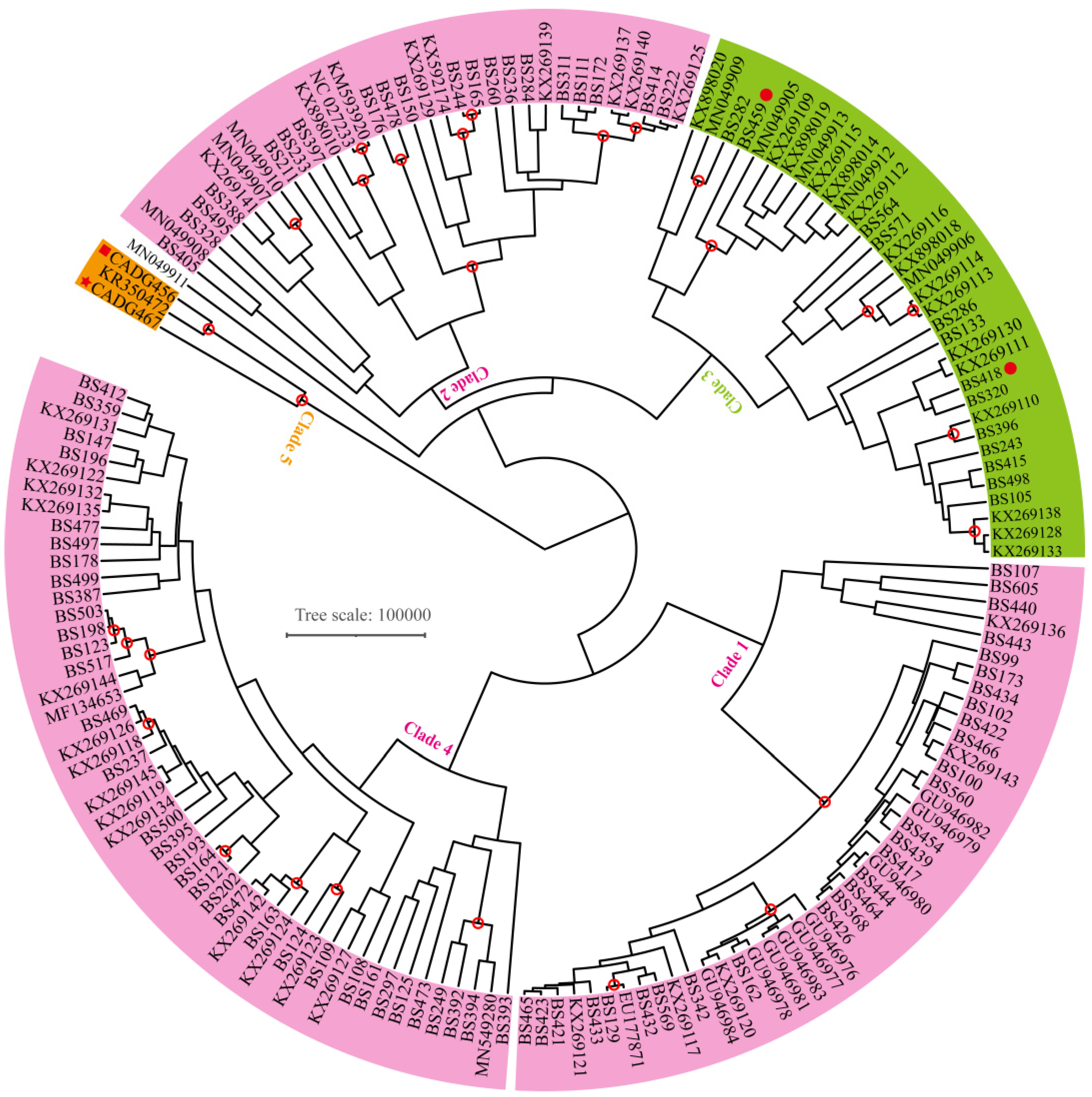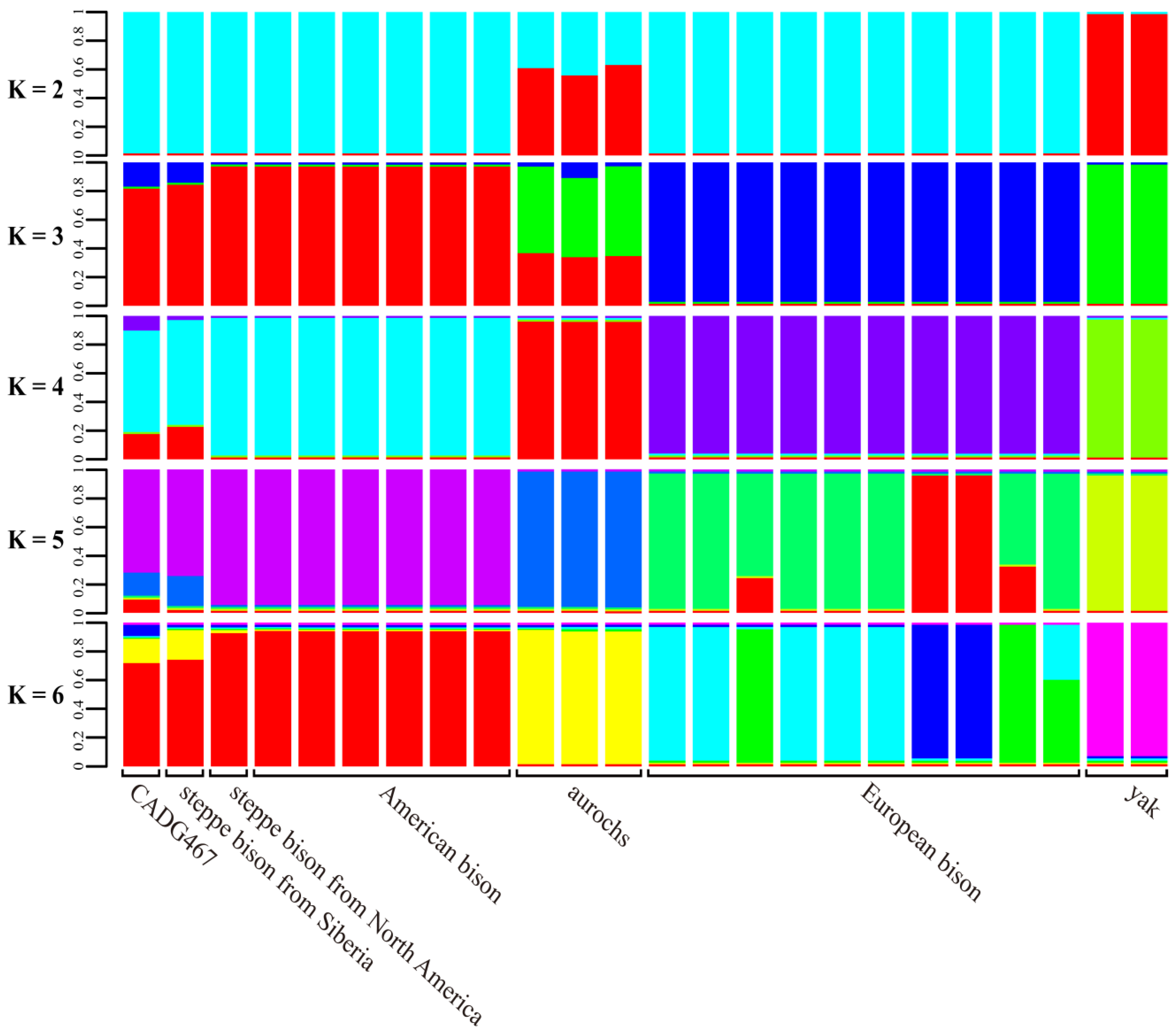Paleogenomes Reveal a Complex Evolutionary History of Late Pleistocene Bison in Northeastern China
Abstract
1. Introduction
2. Materials and Methods
2.1. Sampling Information
2.2. DNA Extraction, Double-Stranded Library Construction and Sequencing
2.3. Single-Stranded Library Construction and Hybridization Capture
2.4. Sequence Assembly
2.5. Mitochondrial Phylogenetic Analyses
2.6. Nuclear Analyses
3. Result
4. Discussion
Supplementary Materials
Author Contributions
Funding
Institutional Review Board Statement
Informed Consent Statement
Data Availability Statement
Acknowledgments
Conflicts of Interest
References
- Grange, T.; Brugal, J.-P.; Flori, L.; Gautier, M.; Uzunidis, A.; Geigl, E.-M. The Evolution and Population Diversity of Bison in Pleistocene and Holocene Eurasia: Sex Matters. Diversity 2018, 10, 65. [Google Scholar] [CrossRef]
- Guthrie, R.D. Bison evolution and zoogeography in North America during the Pleistocene. Q. Rev. Biol. 1970, 45, 1–15. [Google Scholar] [CrossRef] [PubMed]
- Massilani, D.; Guimaraes, S.; Brugal, J.P.; Bennett, E.A.; Tokarska, M.; Arbogast, R.M.; Baryshnikov, G.; Boeskorov, G.; Castel, J.C.; Davydov, S.; et al. Past climate changes, population dynamics and the origin of Bison in Europe. BMC Biol. 2016, 14, 93. [Google Scholar] [CrossRef]
- Skinner, M.F.; Kaisen, O.C. The Fossil Bison of Alaska and Preliminary Revision of the Genus. Bull. Am. Mus. Nat. Hist. 1947, 89, 123–256. [Google Scholar]
- Hedrick, P.W. Conservation Genetics and North American Bison (Bison bison). J. Hered. 2009, 100, 411–420. [Google Scholar] [CrossRef] [PubMed]
- Kowalski, K. The evolution and fossil remains of the European bison. Acta Theriol. 1967, 12, 335–338. [Google Scholar] [CrossRef]
- Rautian, G.S.; Kalabushkin, B.A.; Nemtsev, A.S. A New Subspecies of the European Bison, Bison bonasus montanus ssp. nov. (Bovidae, Artiodactyla). Dokl. Biol. Sci. 2000, 375, 636–640. [Google Scholar] [CrossRef] [PubMed]
- Castaños, J.; Castaños, P.; Murelaga, X. First Complete Skull of a Late Pleistocene Steppe Bison (Bison priscus) in the Iberian Peninsula. Ameghiniana 2016, 53, 543–551. [Google Scholar] [CrossRef]
- Fladerer, F.A.; Roetzel, R.; Veitschegger, K. A Middle Pleistocene steppe bison find within the Dürnstein Castle (Wachau, Lower Austria). Austrian J. Earth Sci. 2020, 113, 237–250. [Google Scholar] [CrossRef]
- Shapiro, B.; Drummond, A.J.; Rambaut, A.; Wilson, M.C.; Matheus, P.E.; Sher, A.V.; Pybus, O.G.; Gilbert, M.T.; Barnes, I.; Binladen, J.; et al. Rise and fall of the Beringian steppe bison. Science 2004, 306, 1561–1565. [Google Scholar] [CrossRef]
- Wilson, M.C. Late quaternary vertebrates and the opening of the ice-free corridor, with special reference to the genusbison. Quat. Int. 1996, 32, 97–105. [Google Scholar] [CrossRef]
- Zver, L.; Toškan, B.; Bužan, E. Phylogeny of Late Pleistocene and Holocene Bison species in Europe and North America. Quat. Int. 2021, 595, 30–38. [Google Scholar] [CrossRef]
- Kirillova, I.V.; Zanina, O.G.; Kosintsev, P.A.; Kul’kova, M.A.; Lapteva, E.G.; Trofimova, S.S.; Chernova, O.F.; Shidlovsky, F.K. The first finding of a frozen Holocene bison (Bison priscus Bojanus, 1827) carcass in Chukotka. Dokl. Biol. Sci. 2013, 452, 296–299. [Google Scholar] [CrossRef] [PubMed]
- Froese, D.; Stiller, M.; Heintzman, P.D.; Reyes, A.V.; Zazula, G.D.; Soares, A.E.R.; Meyer, M.; Hall, E.; Jensen, B.J.L.; Arnold, L.J.; et al. Fossil and genomic evidence constrains the timing of bison arrival in North America. Proc. Natl. Acad. Sci. USA 2017, 114, 3457–3462. [Google Scholar] [CrossRef]
- Funck, J.; Heintzman, P.D.; Murray, G.G.R.; Shapiro, B.; McKinney, H.; Huchet, J.-B.; Bigelow, N.; Druckenmiller, P.; Wooller, M.J. A detailed life history of a pleistocene steppe bison (Bison priscus) skeleton unearthed in Arctic Alaska. Quat. Sci. Rev. 2020, 249, 106578. [Google Scholar] [CrossRef]
- Marsolier-Kergoat, M.C.; Palacio, P.; Berthonaud, V.; Maksud, F.; Stafford, T.; Bégouën, R.; Elalouf, J.M. Hunting the Extinct Steppe Bison (Bison priscus) Mitochondrial Genome in the Trois-Frères Paleolithic Painted Cave. PLoS ONE 2015, 10, e0128267. [Google Scholar] [CrossRef]
- Vershinina, A.O.; Kapp, J.D.; Soares, A.E.R.; Heintzman, P.D.; Lowson, C.; Cassatt-Johnstone, M.; Shidlovskiy, F.K.; Kirillova, I.V.; Shapiro, B. Ancient DNA Analysis of a Holocene Bison from the Rauchua River, Northwestern Chukotka, and the Existence of a Deeply Divergent Mitochondrial Clade. Russ. J. Zool. 2019, 98, 1091–1099. [Google Scholar] [CrossRef]
- Zazula, G.D.; MacKay, G.; Andrews, T.D.; Shapiro, B.; Letts, B.; Brock, F. A late Pleistocene steppe bison (Bison priscus) partial carcass from Tsiigehtchic, Northwest Territories, Canada. Quat. Sci. Rev. 2009, 28, 2734–2742. [Google Scholar] [CrossRef]
- Kirillova, I.V.; Zanina, O.G.; Chernova, O.F.; Lapteva, E.G.; Trofimova, S.S.; Lebedev, V.S.; Tiunov, A.V.; Soares, A.E.R.; Shidlovskiy, F.K.; Shapiro, B. An ancient bison from the mouth of the Rauchua River (Chukotka, Russia). Quat. Res. 2015, 84, 232–245. [Google Scholar] [CrossRef]
- Lister, A.M.; Stuart, A.J. The extinction of the giant deer Megaloceros giganteus (Blumenbach): New radiocarbon evidence. Quat. Int. 2019, 500, 185–203. [Google Scholar] [CrossRef]
- Rey-Iglesia, A.; Lister, A.M.; Campos, P.F.; Brace, S.; Mattiangeli, V.; Daly, K.G.; Teasdale, M.D.; Bradley, D.G.; Barnes, I.; Hansen, A.J. Exploring the phylogeography and population dynamics of the giant deer (Megaloceros giganteus) using Late Quaternary mitogenomes. Proc. Biol. Sci. 2021, 288, 20201864. [Google Scholar] [CrossRef] [PubMed]
- Dong, W.; Xu, Q.Q.; Jin, C.Z.; Li, Y. Succession of the large herbivorous fauna of Northeast China in the Quaternary and its relationship with the paleoclimate. Vertebr. Palasiat. 1996, 34, 58–70. [Google Scholar]
- Fu, R.Y. The age and characteristics of Quaternary mammalian faunas from northeastern China. In Proceedings of the Eighth Annual Meeting of the Chinese Society of Vertebrate Paleontology, Shen Zhen, China, 3–6 November 2001; pp. 167–176. [Google Scholar]
- Wei, H.B.; Liu, Y.H. The Pleistocene mammalian faunas in northeastern China and related paleoenvironment changes. In Proceedings of the Twelfth Annual Meeting of the Chinese Society of Vertebrate Paleontology, Linyi, China, 13–15 September 2010; pp. 53–60. [Google Scholar]
- Zhang, H.C.; Chang, F.Q.; Li, H.Y.; Peng, G.Q.; Duan, L.Z.; Meng, H.W.; Yang, X.J.; Wei, Z.Y. OSL and AMS 14C Age of the Most Complete Mammoth Fossil Skeleton from Northeastern China and its Paleoclimate Significance. Radiocarbon 2019, 61, 347–358. [Google Scholar] [CrossRef]
- Tong, H.W. Warm-preferring animals in Northern China since Quaternary and their paleoenvironmental significance. Sci. China Ser. D 2007, 37, 922–933. [Google Scholar]
- Tong, H.W.; Wang, X.M.; Chen, X. Late Pleistocene Bison priscus from Dabusu in Qian’an County, Jilin, China. Acta Anthropol. Sin. 2013, 32, 485–502. [Google Scholar]
- Wei, Z.Y. The extinct northeastern Chinese bison. Chin. J. Wildl. 1989, 1, 9–10. [Google Scholar]
- Hikoshichiro, M. On Some Fossil Mammals from Ho-nan, China. Sci. Rep. Tohoku Imp. Univ. 2nd Ser. Geol. 1915, 3, 29–38. [Google Scholar]
- Baleka, S.; Herridge, V.L.; Catalano, G.; Lister, A.M.; Dickinson, M.R.; Di Patti, C.; Barlow, A.; Penkman, K.E.H.; Hofreiter, M.; Paijmans, J.L.A. Estimating the dwarfing rate of an extinct Sicilian elephant. Curr. Biol. 2021, 31, 3606–3612. [Google Scholar] [PubMed]
- Slon, V.; Mafessoni, F.; Vernot, B.; de Filippo, C.; Grote, S.; Viola, B.; Hajdinjak, M.; Peyrégne, S.; Nagel, S.; Brown, S.; et al. The genome of the offspring of a Neanderthal mother and a Denisovan father. Nature 2018, 561, 113–116. [Google Scholar] [CrossRef]
- Vilstrup, J.T.; Seguin-Orlando, A.; Stiller, M.; Ginolhac, A.; Raghavan, M.; Nielsen, S.C.; Weinstock, J.; Froese, D.; Vasiliev, S.K.; Ovodov, N.D.; et al. Mitochondrial phylogenomics of modern and ancient equids. PLoS ONE 2013, 8, e55950. [Google Scholar] [CrossRef]
- Hu, J.M.; Westbury, M.V.; Yuan, J.X.; Zhang, Z.; Chen, S.G.; Xiao, B.; Hou, X.D.; Ji, H.; Lai, X.L.; Hofreiter, M.; et al. Ancient mitochondrial genomes from Chinese cave hyenas provide insights into the evolutionary history of the genus Crocuta. Proc. Biol. Sci. 2021, 288, 20202934. [Google Scholar] [CrossRef] [PubMed]
- Meyer, M.; Kircher, M. Illumina sequencing library preparation for highly multiplexed target capture and sequencing. Cold Spring Harb. Protoc. 2010, 2010, 732–741. [Google Scholar] [CrossRef] [PubMed]
- Sheng, G.L.; Basler, N.; Ji, X.P.; Paijmans, J.L.A.; Alberti, F.; Preick, M.; Hartmann, S.; Westbury, M.V.; Yuan, J.X.; Jablonski, N.G.; et al. Paleogenome Reveals Genetic Contribution of Extinct Giant Panda to Extant Populations. Curr. Biol. 2019, 29, 1695–1700. [Google Scholar] [CrossRef]
- Gansauge, M.T.; Meyer, M. Single-stranded DNA library preparation for the sequencing of ancient or damaged DNA. Nat. Protoc. 2013, 8, 737–748. [Google Scholar] [CrossRef] [PubMed]
- Yuan, J.X.; Sheng, G.L.; Preick, M.; Sun, B.Y.; Hou, X.D.; Chen, S.G.; Taron, U.H.; Barlow, A.; Wang, L.Y.; Hu, J.M.; et al. Mitochondrial genomes of Late Pleistocene caballine horses from China belong to a separate clade. Quat. Sci. Rev. 2020, 250, 106691. [Google Scholar] [CrossRef]
- González Fortes, G.; Paijmans, J.L.A. Whole-Genome Capture of Ancient DNA Using Homemade Baits. Methods Mol. Biol. 2019, 1963, 93–105. [Google Scholar]
- Paijmans, J.L.A.; Baleka, S.; Henneberger, K.; Taron, U.H.; Trinks, A.; Westbury, M.V.; Barlow, A. Sequencing single-stranded libraries on the Illumina NextSeq 500 platform. arXiv 2017, arXiv:1711.11004. [Google Scholar]
- Martin, M. Cutadapt removes adapter sequences from high-throughput sequencing reads. EMBnet J. 2011, 17, 10–12. [Google Scholar] [CrossRef]
- Magoč, T.; Salzberg, S.L. FLASH: Fast length adjustment of short reads to improve genome assemblies. Bioinformatics 2011, 27, 2957–2963. [Google Scholar] [PubMed]
- Li, H.; Durbin, R. Fast and accurate long-read alignment with Burrows–Wheeler transform. Bioinformatics 2010, 26, 589–595. [Google Scholar] [CrossRef]
- Li, H.; Handsaker, B.; Wysoker, A.; Fennell, T.; Ruan, J.; Homer, N.; Marth, G.; Abecasis, G.; Durbin, R. The Sequence Alignment/Map format and SAMtools. Bioinformatics 2009, 25, 2078–2079. [Google Scholar] [CrossRef] [PubMed]
- Okonechnikov, K.; Conesa, A.; García-Alcalde, F. Qualimap 2: Advanced multi-sample quality control for high-throughput sequencing data. Bioinformatics 2016, 32, 292–294. [Google Scholar] [CrossRef] [PubMed]
- Jónsson, H.; Ginolhac, A.; Schubert, M.; Johnson, P.L.F.; Orlando, L. mapDamage2.0: Fast approximate Bayesian estimates of ancient DNA damage parameters. Bioinformatics 2013, 29, 1682–1684. [Google Scholar] [CrossRef] [PubMed]
- Stamatakis, A.; Hoover, P.; Rougemont, J. A Rapid Bootstrap Algorithm for the RAxML Web Servers. Syst. Biol. 2008, 57, 758–771. [Google Scholar] [CrossRef] [PubMed]
- Miller, M.A.; Pfeiffer, W.; Schwartz, T. Creating the CIPRES Science Gateway for inference of large phylogenetic trees. In Proceedings of the 2010 Gateway Computing Environments Workshop (GCE), New Orleans, LA, USA, 14 November 2010; pp. 1–8. [Google Scholar]
- Katoh, K.; Misawa, K.; Kuma, K.i.; Miyata, T. MAFFT: A novel method for rapid multiple sequence alignment based on fast Fourier transform. Nucleic Acids Res. 2002, 30, 3059–3066. [Google Scholar] [CrossRef]
- Lanfear, R.; Frandsen, P.B.; Wright, A.M.; Senfeld, T.; Calcott, B. PartitionFinder 2: New Methods for Selecting Partitioned Models of Evolution for Molecular and Morphological Phylogenetic Analyses. Mol. Biol. Evol. 2017, 34, 772–773. [Google Scholar] [CrossRef]
- Drummond, A.J.; Suchard, M.A.; Xie, D.; Rambaut, A. Bayesian Phylogenetics with BEAUti and the BEAST 1.7. Mol. Biol. Evol. 2012, 29, 1969–1973. [Google Scholar] [CrossRef] [PubMed]
- Darriba, D.; Taboada, G.L.; Doallo, R.; Posada, D. jModelTest 2: More models, new heuristics and parallel computing. Nat. Methods 2012, 9, 772. [Google Scholar] [CrossRef] [PubMed]
- Rambaut, A.; Drummond, A.J.; Xie, D.; Baele, G.; Suchard, M.A. Posterior Summarization in Bayesian Phylogenetics Using Tracer 1.7. Syst. Biol. 2018, 67, 901–904. [Google Scholar] [CrossRef]
- Ronquist, F.; Teslenko, M.; van der Mark, P.; Ayres, D.L.; Darling, A.; Höhna, S.; Larget, B.; Liu, L.; Suchard, M.A.; Huelsenbeck, J.P. MrBayes 3.2: Efficient Bayesian Phylogenetic Inference and Model Choice Across a Large Model Space. Syst. Biol. 2012, 61, 539–542. [Google Scholar] [CrossRef]
- Korneliussen, T.S.; Albrechtsen, A.; Nielsen, R. ANGSD: Analysis of Next Generation Sequencing Data. BMC Bioinform. 2014, 15, 356. [Google Scholar] [CrossRef]
- Meisner, J.; Albrechtsen, A. Inferring Population Structure and Admixture Proportions in Low-Depth NGS Data. Genetics 2018, 210, 719–731. [Google Scholar] [CrossRef]
- Skotte, L.; Korneliussen, T.S.; Albrechtsen, A. Estimating individual admixture proportions from next generation sequencing data. Genetics 2013, 195, 693–702. [Google Scholar] [CrossRef]
- Paradis, E.; Claude, J.; Strimmer, K. APE: Analyses of Phylogenetics and Evolution in R language. Bioinformatics 2004, 20, 289–290. [Google Scholar] [CrossRef] [PubMed]
- Soubrier, J.; Gower, G.; Chen, K.; Richards, S.M.; Llamas, B.; Mitchell, K.J.; Ho, S.Y.W.; Kosintsev, P.; Lee, M.S.Y.; Baryshnikov, G.; et al. Early cave art and ancient DNA record the origin of European bison. Nat. Commun. 2016, 7, 13158. [Google Scholar] [CrossRef]
- Zhang, H.C.; Paijmans, J.L.; Chang, F.Q.; Wu, X.H.; Chen, G.J.; Lei, C.Z.; Yang, X.J.; Wei, Z.Y.; Bradley, D.G.; Orlando, L.; et al. Morphological and genetic evidence for early Holocene cattle management in northeastern China. Nat. Commun. 2013, 4, 2755. [Google Scholar] [CrossRef]
- Heintzman, P.D.; Froese, D.; Ives, J.W.; Soares, A.E.R.; Zazula, G.D.; Letts, B.; Andrews, T.D.; Driver, J.C.; Hall, E.; Hare, P.G.; et al. Bison phylogeography constrains dispersal and viability of the Ice Free Corridor in western Canada. Proc. Natl. Acad. Sci. USA 2016, 113, 8057. [Google Scholar] [CrossRef]
- Zazula, G.D.; Hall, E.; Hare, P.G.; Thomas, C.; Mathewes, R.; La Farge, C.; Martel, A.L.; Heintzman, P.D.; Shapiro, B. A middle Holocene steppe bison and paleoenvironments from the Versleuce Meadows, Whitehorse, Yukon, Canada. Can. J. Earth Sci. 2017, 54, 1138–1152. [Google Scholar] [CrossRef]
- Mendez, F.L.; Krahn, T.; Schrack, B.; Krahn, A.M.; Veeramah, K.R.; Woerner, A.E.; Fomine, F.L.; Bradman, N.; Thomas, M.G.; Karafet, T.M.; et al. An African American paternal lineage adds an extremely ancient root to the human Y chromosome phylogenetic tree. Am. J. Hum. Genet. 2013, 92, 454–459. [Google Scholar] [CrossRef]
- Richards, S.M.; Hovhannisyan, N.; Gilliham, M.; Ingram, J.; Skadhauge, B.; Heiniger, H.; Llamas, B.; Mitchell, K.J.; Meachen, J.; Fincher, G.B.; et al. Correction: Low-cost cross-taxon enrichment of mitochondrial DNA using in-house synthesised RNA probes. PLoS ONE 2019, 14, e0213296. [Google Scholar] [CrossRef]
- Richards, S.M.; Mitchell, K.J.; Tobler, R.; Cooper, A. Recombinase Polymerase Amplification (RPA) versus PCR for ancient DNA library amplification. PeerJ Preprints 2019, 7, 27541–27544. [Google Scholar]
- Wu, D.D.; Ding, X.D.; Wang, S.; Wójcik, J.M.; Zhang, Y.; Tokarska, M.; Li, Y.; Wang, M.S.; Faruque, O.; Nielsen, R.; et al. Pervasive introgression facilitated domestication and adaptation in the Bos species complex. Nat. Ecol. Evol. 2018, 2, 1139–1145. [Google Scholar] [CrossRef]
- Verdugo, M.P.; Mullin, V.E.; Scheu, A.; Mattiangeli, V.; Daly, K.G.; Delser, P.M.; Hare, A.J.; Burger, J.; Collins, M.J.; Kehati, R.; et al. Ancient cattle genomics, origins, and rapid turnover in the Fertile Crescent. Science 2019, 365, 173–176. [Google Scholar] [CrossRef]
- Qiu, Q.; Wang, L.Z.; Wang, K.; Yang, Y.Z.; Ma, T.; Wang, Z.F.; Zhang, X.; Ni, Z.Q.; Hou, F.J.; Long, R.J.; et al. Yak whole-genome resequencing reveals domestication signatures and prehistoric population expansions. Nat. Commun. 2015, 6, 10283. [Google Scholar] [CrossRef]






Publisher’s Note: MDPI stays neutral with regard to jurisdictional claims in published maps and institutional affiliations. |
© 2022 by the authors. Licensee MDPI, Basel, Switzerland. This article is an open access article distributed under the terms and conditions of the Creative Commons Attribution (CC BY) license (https://creativecommons.org/licenses/by/4.0/).
Share and Cite
Hou, X.; Zhao, J.; Zhang, H.; Preick, M.; Hu, J.; Xiao, B.; Wang, L.; Deng, M.; Liu, S.; Chang, F.; et al. Paleogenomes Reveal a Complex Evolutionary History of Late Pleistocene Bison in Northeastern China. Genes 2022, 13, 1684. https://doi.org/10.3390/genes13101684
Hou X, Zhao J, Zhang H, Preick M, Hu J, Xiao B, Wang L, Deng M, Liu S, Chang F, et al. Paleogenomes Reveal a Complex Evolutionary History of Late Pleistocene Bison in Northeastern China. Genes. 2022; 13(10):1684. https://doi.org/10.3390/genes13101684
Chicago/Turabian StyleHou, Xindong, Jian Zhao, Hucai Zhang, Michaela Preick, Jiaming Hu, Bo Xiao, Linying Wang, Miaoxuan Deng, Sizhao Liu, Fengqin Chang, and et al. 2022. "Paleogenomes Reveal a Complex Evolutionary History of Late Pleistocene Bison in Northeastern China" Genes 13, no. 10: 1684. https://doi.org/10.3390/genes13101684
APA StyleHou, X., Zhao, J., Zhang, H., Preick, M., Hu, J., Xiao, B., Wang, L., Deng, M., Liu, S., Chang, F., Sheng, G., Lai, X., Hofreiter, M., & Yuan, J. (2022). Paleogenomes Reveal a Complex Evolutionary History of Late Pleistocene Bison in Northeastern China. Genes, 13(10), 1684. https://doi.org/10.3390/genes13101684







